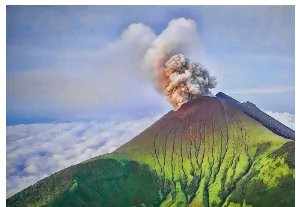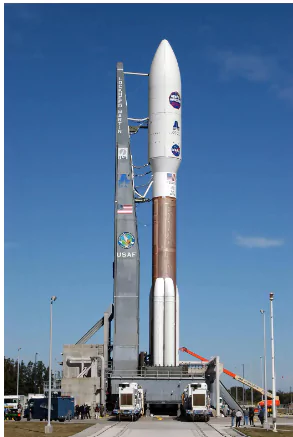Mount Kanlaon

|
- Recently, Mount Kanlaon volcano erupted in the central Philippines, prompting hundreds of people to seek refuge in evacuation centres.
- About: Mount Kanlaon is a stratovolcano in the north-central part of Negros Island in the Philippines.
- It is the tallest mountain on the island and the 42nd highest peak on any island in the world.
- It is an active volcano in the Philippines and part of the Pacific Ring of Fire, and has multiple pyroclastic cones and craters.
- Geological Characteristics: The summit of Kanlaon volcano features a broad, elongated caldera with a crater lake and a smaller, more active crater to the south.
- It is made of tropical volcanic materials like lava flows, lahar deposits, tephra, and pyroclastic deposits.
- Kanlaon’s slopes act as headwater catchments for the major river systems on Negros Island.
- Fauna: Blue Whale, Palm Civet, Spotted Deer, Writhed Hornbill
- Flora: Trees like Tangili, Dao, Red Lauan, and Pometia Pinnata are found here
- Eruptions: Typically, these eruptions involve small to moderate-sized phreatic eruptions, leading to minor ash falls near the volcano.
Phreatic Eruption
- About: A phreatic eruption happens when volcanic activity heats water underground or on the surface, leading to a steam-driven explosion.
- Process: Heated water starts boiling or can instantly turn into steam, triggering an explosion. Phreatic eruptions may happen before, during, or after a conventional volcanic eruption.
- Causes: The proximity of groundwater to volcanic vents results in its heating as magma ascends, causing these phreatic eruptions.
|
Indo-Pacific Economic Framework for Prosperity (IPEF) Ministerial Meeting
|
Key Highlights of the Meeting:
- IPEF Clean Economy Agreement: The IPEF Clean Economy Agreement accelerates energy transition and climate resilience efforts by promoting clean energy technologies, fostering collaboration
- Cooperative Work Programme (CWP): India announced a new Cooperative Work Programme (CWP) on “e-waste urban mining” within the IPEF.
- It aims to enhance sustainable e-waste management among partners by exchanging information and developing solutions for efficient recovery and recycling of critical materials.
- IPEF Catalytic Capital Fund: IPEF partners praised the launch of the IPEF Catalytic Capital Fund, aiding the development of clean economy infrastructure projects in emerging and upper-middle-income economies.
- IPEF Fair Economy Agreement: It promotes transparent business environments, trade, and investment while combating corruption and enhancing tax transparency through private-sector collaboration.
- IPEF Upskilling Initiative: IPEF partners celebrated progress on the IPEF Upskilling Initiative, launched in 2022. This initiative offers digital skills training to primarily women and girls in emerging and middle-income partner countries.
Indo-Pacific Economic Framework for Prosperity (IPEF)
- About: IPEF was launched on 23 May 2022 in Tokyo, Japan, comprising 14 countries.
- Australia, Brunei, Fiji, India, Indonesia, Japan, Republic of Korea, Malaysia, New Zealand, Philippines, Singapore, Thailand, Vietnam and USA.
- Aim: The IPEF seeks to strengthen economic engagement and cooperation among partner countries with the goal of advancing growth, economic stability and prosperity in the region.
- Framework: The framework is structured around four pillars
- Pillar 1: Trade
- Pillar 2: Supply Chain Resilience
- Pillar 3: Clean Economy
- Pillar 4: Fair Economy.
- India had joined Pillars 2, 3 and 4 of IPEF while maintaining an observer status in Pillar 1.
|
Price Stabilization Fund (PSF)
|
- The Centre is planning to purchase one million tonnes (mt) of chana (gram) under its price stabilization fund (PSF) at market prices or even higher to replenish its buffer.
- About: The Price Stabilization Fund (PSF) was established during the fiscal year 2014-15 under the Department of Agriculture, Cooperation & Farmers Welfare (DAC&FW).
- Subsequently, in 2016, the PSF scheme was transferred to the Department of Consumer Affairs (DOCA).
- Regulation: The centrally managed Price Stabilisation Fund Management Committee (PSFMC) has the authority to approve proposals from both State Governments and central agencies.
- The Small Farmers Agribusiness Consortium (SFAC) oversees the PSF as a central corpus fund.
- Objective: The primary objective of the PSF is to regulate the prices of selected commodities by either distributing or procuring the commodity to maintain price stability within a specific range.
- The fund is typically utilized for interventions aimed at mitigating high or low prices of commodities.
- Functions: It stabilizes prices of key agri-horticultural commodities like onions, potatoes, and pulses.
- The PSF provides interest-free working capital advances to Central Agencies and State/UT Governments for market interventions.
- It supports both domestic procurement and imports.
- Interest-free loans under the PSF scheme cover working capital and related expenses for commodity procurement and distribution by State Governments/Union Territories and Central Agencies.
|
H5N2 Bird Flu
|
- Recently, the first known human case of H5N2 bird flu has been reported in Mexico City, involving a 59-year-old man who succumbed to the infection.
About: H5N2 is one of the subtypes of the Avian Influenza A virus.
- Subtypes: Influenza A viruses are classified into subtypes according to the proteins present on their surfaces.
- These subtypes include 18 different hemagglutinin (H) and 11 neuraminidase (N) variants, including H5N2.
- Hemagglutinin is a glycoprotein found on the surface of influenza viruses, while neuraminidase is an enzyme also found on their surface. It aids in the release of the viruses from the host cell.
- Spread Factors: Although the precise causes of widespread H5N2 outbreaks are not fully understood, factors such as migratory bird movements and interactions with domestic poultry play a role in its dissemination.
- Environmental Changes: Changes in environmental conditions like those impacting H5N1 may affect H5N2 spread by altering bird migration routes and behaviours.
- Human Transmission: While instances of human contraction of H5N2 are uncommon, the potential for the virus to mutate and enhance its transmissibility among humans while maintaining its severity presents a notable public health concern.
- Health Impacts: Infection with avian influenza viruses in humans can result in mild to severe upper respiratory tract illnesses and may lead to fatalities.
- Additionally, cases of conjunctivitis, gastrointestinal symptoms, encephalitis, and encephalopathy have been documented.
- Diagnosis: Molecular techniques such as Real-Time Polymerase Chain Reaction (RT-PCR) are employed for disease diagnosis.
- Treatment: Antiviral medications, particularly neuraminidase inhibitors like oseltamivir and zanamivir, can shorten the duration of viral replication.
|
Atlas V Rocket

|
- The United Launch Alliance Atlas V rocket is prepared to launch Boeing’s Starliner spacecraft for NASA on its maiden crewed mission.
- About: Atlas V is a rocket system that can only be used once. It’s the fifth main version in the Atlas family of rockets.
- Operation: Initially created by Lockheed Martin, the Atlas V is currently managed by United Launch Alliance (ULA), a collaboration between Lockheed Martin and Boeing.
- Purpose: The Atlas V serves various purposes, including carrying payloads for the Department of Defense (DoD), NASA, and commercial ventures.
- Additionally, it holds the distinction of being America’s longest-serving operational rocket.
Boeing Starliner:
- About: Starliner is a spacecraft that carries astronauts to space, launched by a rocket. It has a crew capsule and a service module.
- Objectives:
-
- Transporting Astronauts to the ISS: Starliner’s main goal is to ferry astronauts to and from the International Space Station, functioning as a crewed spacecraft capable of accommodating up to seven astronauts.
- Commercial Crew Transportation: Starliner, alongside SpaceX’s Dragon crew capsule, offers NASA commercial crew transportation alternatives to the ISS, reducing dependence on Russia’s Soyuz rocket and capsule.
- Supporting ISS Operations: Following the retirement of NASA’s Space Shuttle program in 2011 and preceding the availability of commercial crew spacecraft, reliance on Russia’s Soyuz was the sole means of transporting astronauts to the ISS.
- The introduction of Starliner aims to ensure continuity in ISS operations by providing supplementary transportation capabilities.
|
![]() 7 Jun 2024
7 Jun 2024
